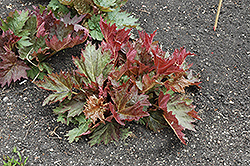It's all about ...
plants

Rote Auslese Ornamental Rhubarb
Rheum palmatum 'Rote Auslese'
Plant Height: 3 feet
Flower Height: 6 feet
Spread: 5 feet
Sunlight:
![]()
![]()
Hardiness Zone: 4a
Other Names: Red Selection, Red Select
Description:
A prehistoric looking plant with colossal, deeply divided dark green leaves that turn vivid red in the fall; plumes of the dark red to maroon flowers tower loftily above the massive plants in summer
Ornamental Features
Rote Auslese Ornamental Rhubarb features airy panicles of dark red flowers held atop the stems from early to mid summer. Its attractive enormous serrated lobed leaves emerge antique red in spring, turning dark green in colour with curious purple undersides. The foliage often turns cherry red in fall.
Landscape Attributes
Rote Auslese Ornamental Rhubarb is an herbaceous perennial with a rigidly upright and towering form. Its wonderfully bold, coarse texture can be very effective in a balanced garden composition.
This plant will require occasional maintenance and upkeep, and should be cut back in late fall in preparation for winter. Deer don't particularly care for this plant and will usually leave it alone in favor of tastier treats. It has no significant negative characteristics.
Rote Auslese Ornamental Rhubarb is recommended for the following landscape applications;
- Vertical Accent
- General Garden Use
- Bog Gardens
Planting & Growing
Rote Auslese Ornamental Rhubarb will grow to be about 3 feet tall at maturity extending to 6 feet tall with the flowers, with a spread of 5 feet. It grows at a fast rate, and under ideal conditions can be expected to live for approximately 10 years. As an herbaceous perennial, this plant will usually die back to the crown each winter, and will regrow from the base each spring. Be careful not to disturb the crown in late winter when it may not be readily seen!
This plant does best in full sun to partial shade. It is quite adaptable, prefering to grow in average to wet conditions, and will even tolerate some standing water. It is not particular as to soil type or pH. It is highly tolerant of urban pollution and will even thrive in inner city environments. This is a selected variety of a species not originally from North America. It can be propagated by division; however, as a cultivated variety, be aware that it may be subject to certain restrictions or prohibitions on propagation.
This plant is not reliably hardy in our region, and certain restrictions may apply; contact the store for more information.
